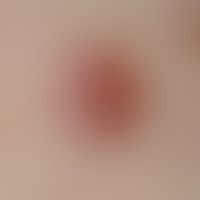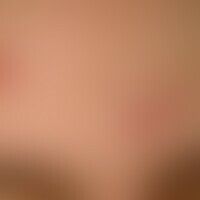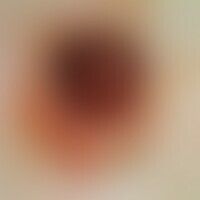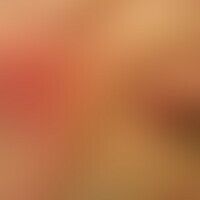
Urticaria acute spontaneous L50.8
Acute spontaneous urticaria with angioedema; since a few days rather discreetly developed urticaria with recurrent angioedema of the eyelids (which characterizes the clinical picture).

Erythema infectiosum B08.30
erythema infectiosum. after slight "flu-like" infection intensive redness (and swelling) of both cheeks (cheek whistle face). 2 days later little symptomatic exanthema with anular erythema on the arms. cervical lymphadenopathy. laboratory: o.B.

Teleangiectasia I78.8
Teleangiectasia. Harm sleeve, reticularly branched, irregular vascular dilatations in the area of both cheeks.

Merkel cell carcinoma C44.L
Merkel cell carcinoma. solitary, fast growing, asymptomatic, bright red, coarse, shifting, smooth lump with atrophic surface. the appearance in the area of UV-exposed sites is typical.

Chronic actinic dermatitis (overview) L57.1
Dermatitis chronic actinic: Chronic laminar eczema reaction which is essentially limited to the exposed skin areas Typical of chronic actinic dermatitis and thus distinguishable from a toxic light reaction (type acute solar dermatitis) is the blurred transition (eczematous scattering reactions) from lesional to healthy skin.

Acne (overview) L70.0
Acne vulgaris (overview): severe clinical picture with inflammatory papules, papulo-pustules and pustules in a 17-year-old patient; increasing course of the disease since 2 years. extensive scarring beginning in the central cheek area. picture of acne vulgaris (type: acne papulo-pustulosa, grade IV). classic indication for systemic isotretinoin therapy!

Basal cell carcinoma sclerodermiformes C44.L

Leprosy reaction A30.8
Leprosy reaction type I: Cell-mediated inflammatory (flare-up) reaction in existing leprosy foci, here lepromatous leprosy.

Rosacea L71.1; L71.8; L71.9;
Rosacea: Rosacea papulopustulosa 2 years after "low dose - isotretinoin therapy" .

Asymmetrical nevus flammeus Q82.5
Naevus flammeus (Port-wine stain): congenitalerythema in the facial region (capillary vascular malformation), localized in V2 distribution, completely without symptoms. 4-month-old boy, developed according to age.

Infant haemangioma (overview) D18.01
Haemangioma of the infant (series: 3-month-old infant); initial findings of a large hemangioma with little elevation.

Basal cell carcinoma (overview) C44.-
Basal cell carcinoma (overview): Nodular basal cell carcinoma with a shiny, smooth surface interspersed with bizarre telangiectases.












